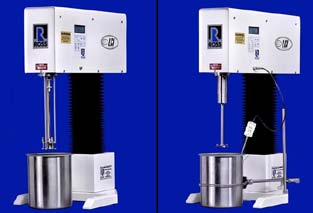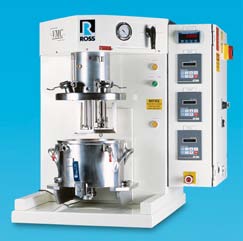Tech Report
Conserve raw materials in a scalable R&D mixer.

Technology Brief
Scalable mixing equipment allow R&D scientists to conserve expensive ingredients while following a repeatable, consistent agitation method that can be easily replicated in pilot or production scale. This bulletin presents some R&D mixers and their smallest recommended batch volumes.
Mix small, think big
Developing a new formulation at the R&D stage can require multiple iterations to arrive at the optimal quality, functionality, cost or a combination of these and other factors. Typically, mixing at this scale is relatively easy to accomplish. Blade size and agitator power are easily oversized in a bench-top setting and any heat transfer or chemical reaction that accompanies the mixing step is completed rather quickly.
When working with rare or expensive raw materials, it pays to prepare the smallest batch size possible that will still produce enough samples for testing and analysis. At the same time, the laboratory mixer must be scalable so that results can be replicated at larger volumes in a straightforward manner. While many styles of R&D mixers are available, such as magnetic stirrers and kitchen-type single planetary mixers, many of these devices are not scalable equipment and will require extra time and resources for experimentation once the product graduates to pilot or production scale.
Some scalable R&D mixers
- The double planetary mixer (DPM) moves material by rotating two identical blades on their own axes as they orbit on a common axis. The blades continuously advance along the periphery of the mix vessel, removing material from the walls and transporting it towards the interior. DPM`s are ideal for mixing thick gels, viscous pastes and dough-like materials. They are also used for vacuum drying pastes or slurries into free-flowing powder. Half-pint models are available and these can handle batches as little as approximately 100ml.
- Bench-top high shear mixers can process batch volumes as low as 1 liter using interchangeable rotor/stator heads, sawtooth dispersers and propeller blades. A special micro rotor/stator attachment is designed for even smaller batches in the range of 50-500ml. Laboratory inline rotor/stators are also available. As an R&D tool, inline mixers are quite versatile in terms of the amount of product that can be processed and they offer precise control over the mixing process since the exact number of passes through the high-shear zone can be monitored with confidence. Pictured on the right is a laboratory inline rotor/stator mixer with a small recirculation vessel, valves, piping and pressure gauge.
- Multi-shaft mixers consist of two or three independently-driven agitators working in tandem. A high speed disperser quickly draws powders into the liquid batch through a powerful vortex. The rotor/stator carries out a number of tasks depending on the product being mixed - it can puree solid ingredients, break down agglomerates, or prepare fine droplets in an emulsion. Finally, a low-speed anchor promotes bulk flow and uniform batch temperature while scraping the vessel sidewalls and bottom. Working capacities of multi-shaft lab mixers start from around 0.5 to 0.75 gallons. They are highly versatile not only in the range of agitation conditions but also the variety of applications they can handle, from thin slurries and solutions to viscous pastes and suspensions. For even higher viscosities (>500,000 cP), "hybrid" planetary mixers are used where the high speed disperser rotates around the vessel, instead of having a fixed axis of rotation, and is complemented by a planetary stirrer.
- Ribbon blenders are commonly used for straightforward dry blending (solid-solid) applications. The classic design features a U-shaped horizontal trough and an agitator made up of inner and outer helical ribbons that are pitched to move material axially in opposite directions, as well as radially. The smallest laboratory ribbon blender model has a 0.5-cu.ft. working capacity and can accommodate batches as small as 2 gallons.
Ross Laboratory Mixers

Batch High Shear Mixer

Multi-Shaft Mixers

Double Planetary Mixer

Ribbon Blender
Sample Application: Brazing Paste

A Ross Laboratory Model DPM-1Quart Double Planetary Mixer is being used to prepare small batches of precious metal brazing and soldering pastes. The high quality pastes are used in the manufacture of precision components such as sensors, medical and telecommunications equipment, aerospace parts, cutting tools and many others.